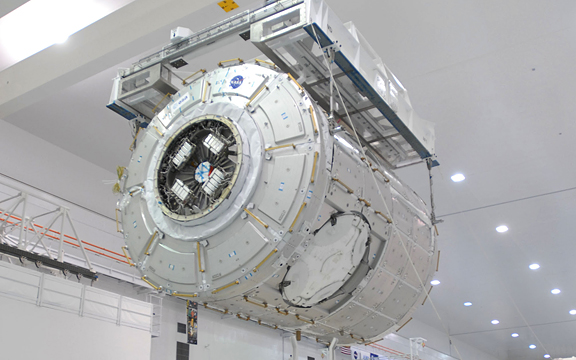|
|||||||
|
|
|
 |
|
|
Strumenti |
|
|
#161 |
|
Senior Member
Iscritto dal: Sep 2001
Città: de_legato
Messaggi: 792
|
mazz quant'è grosso ....ed è tutta roba del Giappone, cioè un paese 4 volte più piccolo dell'europa!!
ps: ma la piccola parte sopra a che serve? ...è pressurizzata?
__________________
---------------------------------------------- File reality.sys corrupted, Reboot Universe? Y/N ---------------------------------------------- |
|
|

|
|
|
#162 |
|
Senior Member
Iscritto dal: Apr 2006
Messaggi: 1464
|
|
|
|

|
|
|
#163 |
|
Senior Member
Iscritto dal: Apr 2006
Messaggi: 1464
|
|
|
|

|
|
|
#164 |
|
Senior Member
Iscritto dal: Feb 2002
Messaggi: 7072
|
manca solo la cupola?
|
|
|

|
|
|
#165 |
|
Senior Member
Iscritto dal: Apr 2006
Messaggi: 1464
|
Tralasciando i russi (che devono ancora lanciare il Multipurpose Laboratory Module, un airlock nuovo e un mini-modulo di docking per le Soyuz) "una volta" mancavano solo il Nodo 3, che adesso si chiama Tranquility, e Cupola.
Con le ultime aggiunte ci saranno anche: - PLM (Permanent Logistic Module): ovvero un MPLM modificato per la permanenza costante in orbita e che verrà utilizzato come "magazzino". - AMS (Alpha Magnetic Spectrometer): il "famoso" esperimento di fisica delle particelle. Verrà montato sul truss della ISS. |
|
|

|
|
|
#166 |
|
Senior Member
Iscritto dal: Mar 2002
Città: Treviso
Messaggi: 911
|
Ammazza quanto sono piccoli i pannelli solari delle Soyuz (o progress, non vedo bene) rispetto a quelli mastodontici dell'ISS
|
|
|

|
|
|
#167 | |
|
Senior Member
Iscritto dal: Sep 2001
Città: de_legato
Messaggi: 792
|
Quote:
Però bella come sfida tecnologica ...sopratutto adesso che si stà concretizzando
__________________
---------------------------------------------- File reality.sys corrupted, Reboot Universe? Y/N ---------------------------------------------- |
|
|
|

|
|
|
#168 | |
|
Senior Member
Iscritto dal: Apr 2006
Messaggi: 1464
|
Quote:
|
|
|
|

|
|
|
#169 | |
|
Senior Member
Iscritto dal: Apr 2006
Messaggi: 1464
|
Quote:
|
|
|
|

|
|
|
#170 | ||
|
Senior Member
Iscritto dal: Apr 2006
Messaggi: 1464
|
Quote:
Quote:
|
||
|
|

|
|
|
#171 | |
|
Senior Member
Iscritto dal: Apr 2006
Messaggi: 1464
|
 Quote:
|
|
|
|

|
|
|
#172 | |
|
Senior Member
Iscritto dal: Apr 2006
Messaggi: 1464
|
Quote:
|
|
|
|

|
|
|
#173 |
|
Senior Member
Iscritto dal: Mar 2002
Città: Treviso
Messaggi: 911
|
Sbaglio o la Soyuz che si vede in una delle foto ha i pannelli danneggiati?
(non che siano di importanza fondamentale ora) |
|
|

|
|
|
#174 |
|
Senior Member
Iscritto dal: Nov 2003
Città: Utopia Planitia
Messaggi: 3875
|
Beh uddio, non dovrebbe essere una capsula di salvataggio?!
__________________

|
|
|

|
|
|
#175 | |
|
Senior Member
Iscritto dal: Apr 2006
Messaggi: 1464
|
Quote:
(Da cosa possa dipendere questa disomogeneità non lo so..) |
|
|
|

|
|
|
#176 |
|
Senior Member
Iscritto dal: Mar 2002
Città: Treviso
Messaggi: 911
|
|
|
|

|
|
|
#177 | |
|
Senior Member
Iscritto dal: Apr 2006
Messaggi: 1464
|
Quote:
|
|
|
|

|
|
|
#178 | |
|
Senior Member
Iscritto dal: Apr 2006
Messaggi: 1464
|
Wayne Hale ha un parere "critico" (per usare un eufemismo
Quote:
 |
|
|
|

|
|
|
#179 |
|
Senior Member
Iscritto dal: Nov 2003
Città: Utopia Planitia
Messaggi: 3875
|
Purtroppo sono sempre i soldi i problema, se non fosse per la guerra in Afghanistan o Irak probabilmente le cose sarebbero diverse, oppure se ai tempi dell'incidente del columbia il progetto fosse stato ancora vivo adesso avremo meno problemi.
__________________

|
|
|

|
|
|
#180 |
|
Senior Member
Iscritto dal: Mar 2002
Città: Treviso
Messaggi: 911
|
Una fine simile l'ha fatta anche l'X-33 (anche se c'erano alcuni problemi di masse da risolvere - superati, ironia della sorte, troppo tardi per salvare il progetto)
Sono sempre stato affascinato dai Lifting Bodies (anche lo Space Shuttle e' in parte un lifting body, con in piu' le ali a delta! Non sarebbe male se ri-tirassero fuori dal cappello l'X-38! |
|
|

|

|
| Strumenti | |
|
|
Tutti gli orari sono GMT +1. Ora sono le: 12:04.






























